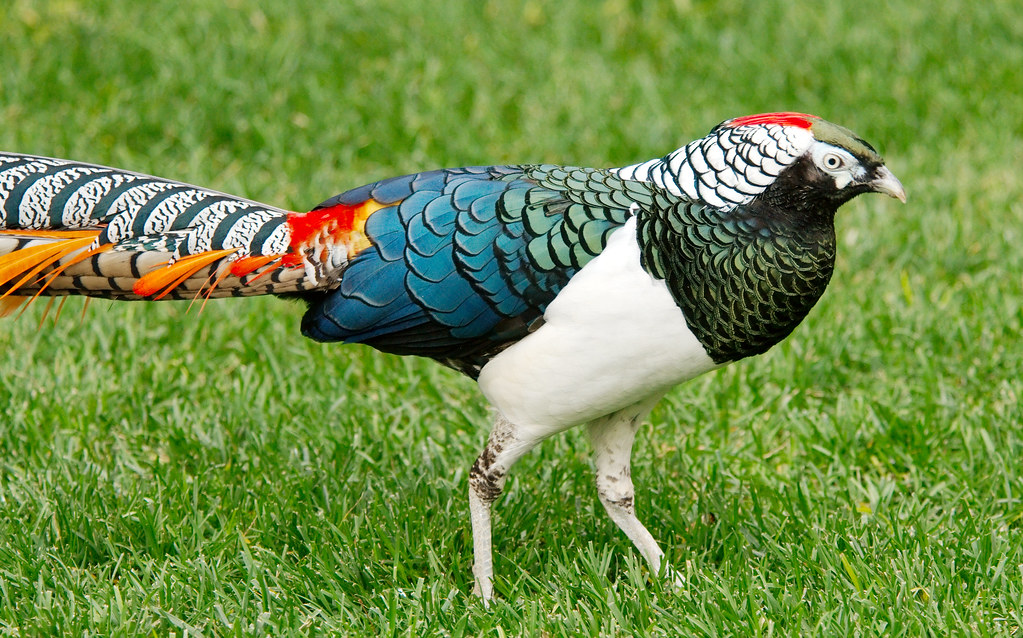Hidden Gems of the Feathered Realm: Discovering the Secrets of Lady Amherst’s Pheasant
Table of Contents
Native to Myanmar and southern China, the Lady Amethyst Pheasant, scientifically known as Chrysolophus amherstiae, belongs to the Phasianidae family. Bearing a striking resemblance to its cousin, the Golden Pheasant, the adult male Lady Amethyst Pheasant measures 100-120 cm in length, with its impressive tail accounting for 80 cm of the total.
Adorned in a captivating plumage of white and yellow, complemented by a silver-blackish head, the Lady Amethyst Pheasant presents a regal spectacle. The elongated tail, a prominent feature, is elegantly colored in shades of grey. In contrast, the female, less ostentatious, dons a mottled brown plumage with a subdued head and cleaner underparts.
While primarily considered a domesticated species, the Lady Amethyst Pheasant demonstrates adaptability, thriving in dense forests. Although predominantly a ground-dwelling bird, it possesses remarkable agility in flight. The Lady Amethyst Pheasant’s diet encompasses grains, leaves, seeds, and small insects, contributing to its resilience and ability to flourish in various environments.
Lady Amherst’s Pheasant: Facts, Diet, Habitat, Details
Lady Amherst’s Pheasant, scientifically identified as Chrysolophus amherstiae, is an avian wonder native to the lush landscapes of southwestern China and northern Myanmar. This striking member of the Phasianidae family exhibits fascinating anatomical features and ecological adaptability that contribute to its thriving existence.
Anatomy and Physiology:
The adult male Lady Amherst’s Pheasant stands out with a remarkable length of 100-120 cm, with a tail accounting for an impressive 80 cm of its total length. Adorned in a resplendent plumage of white and yellow, accompanied by a silver-blackish head, this species captivates onlookers with its regal appearance. The elongated tail, colored in shades of grey, adds to the bird’s visual grandeur. In contrast, the female exhibits a more subdued mottled brown plumage, complemented by a darker head and cleaner underparts. This intricate interplay of colors and features showcases the species’ remarkable diversity within its population.
Ecology and Habitat:
Lady Amherst’s Pheasant, native to the dense forests of southwestern China and northern Myanmar, thrives in diverse ecological settings. While often considered a domesticated species, it displays a notable ability to flourish in its natural habitat. The species’ adaptability allows it to navigate both open landscapes and dense woodlands. This ecological versatility contributes to the species’ survival and propagation, highlighting its significance in maintaining biodiversity within its native regions.
Diet:
The Lady Amherst’s Pheasant sustains itself through a varied diet, reflecting its adaptability to different environments. Its nutritional intake includes grains, leaves, seeds, and small insects. This dietary flexibility ensures the species can thrive in a range of habitats, from forested areas to more open landscapes. The intricate relationship between the Lady Amherst’s Pheasant and its environment underscores the delicate balance required for the species’ sustenance and well-being.
Behavioral Insights:
Lady Amherst’s Pheasant exhibits a ground-dwelling behavior, characteristic of many pheasant species. Despite being primarily terrestrial, this species showcases impressive flying abilities. The swift flight of the Lady Amherst’s Pheasant allows it to navigate its surroundings with agility, contributing to its overall adaptability in various ecological niches. These behavioral nuances emphasize the importance of understanding not only the anatomical but also the behavioral aspects of the species for a comprehensive ecological assessment.
Conservation Considerations:
While Lady Amherst’s Pheasant is not currently listed as endangered, its conservation status is of paramount importance. Human activities, habitat degradation, and potential threats to the delicate ecological balance of its native regions necessitate ongoing conservation efforts. Preserving the diverse landscapes of southwestern China and northern Myanmar is crucial for ensuring the continued well-being of this magnificent species and its role in maintaining the ecological equilibrium.
In conclusion, Lady Amherst’s Pheasant stands as a testament to the intricate interplay of anatomy, physiology, and ecology within the avian kingdom. From its regal appearance to its ecological adaptability and dietary flexibility, this species exemplifies the wonders of nature. Understanding and appreciating the multifaceted aspects of Lady Amherst’s Pheasant contribute not only to our knowledge of the avian world but also to the broader conversation about biodiversity conservation and habitat preservation in southwestern China and northern Myanmar.
Read more: Madagascar Ring-tailed Lemur

